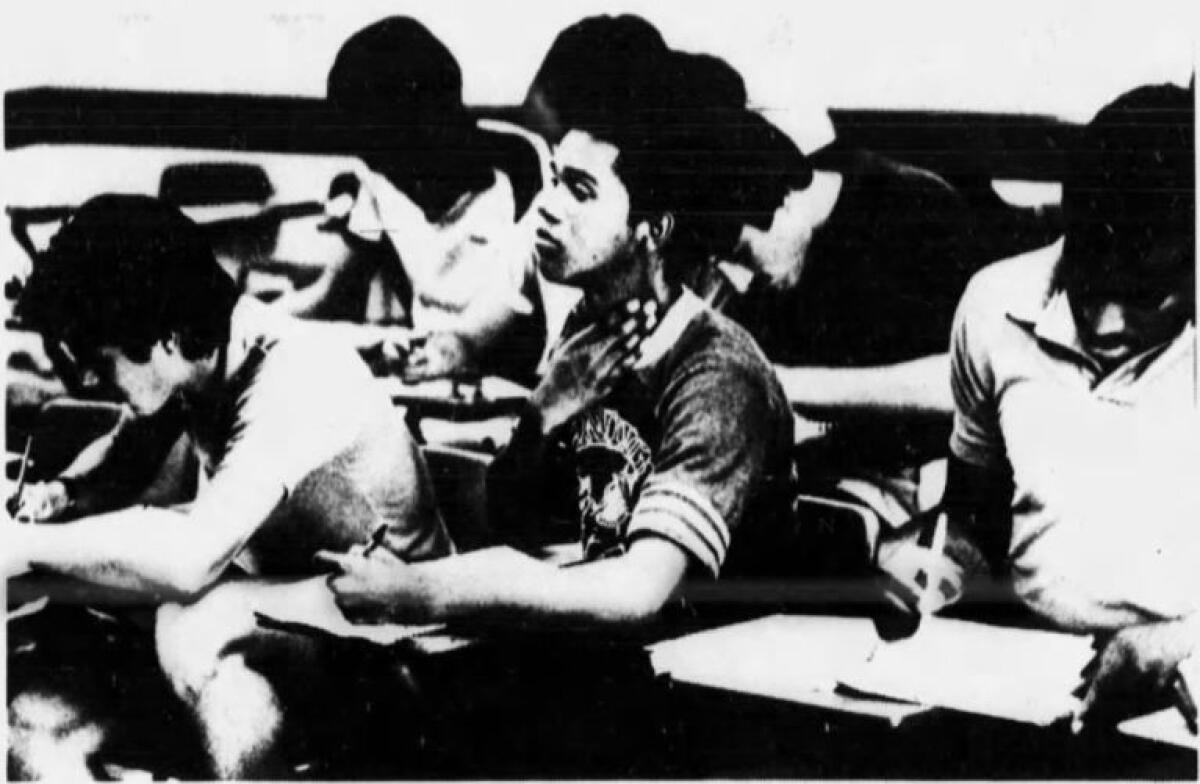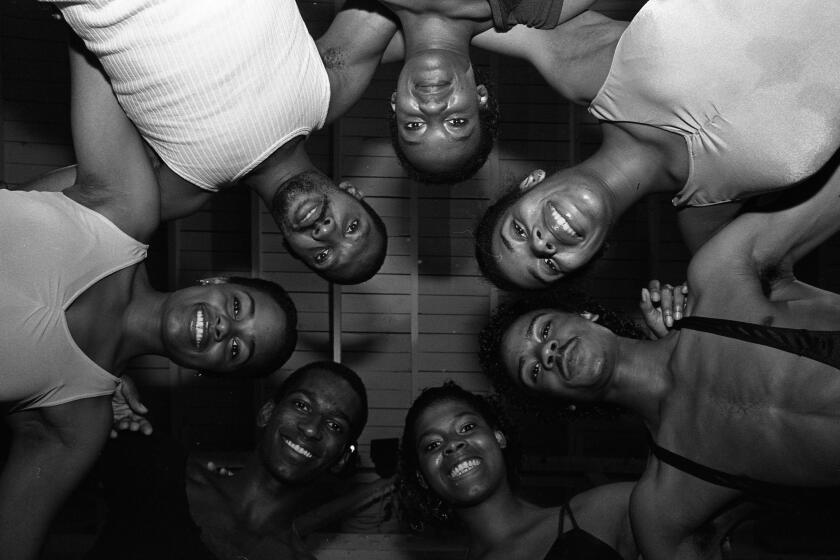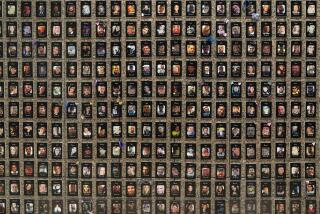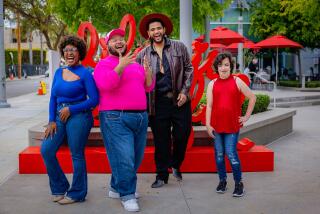Desire, despair: Black youth — Changing generation

This story originally ran in 1982 as part of the “Black L.A.: Looking at Diversity” series. We have preserved the original text in order to provide an accurate account of the work in print.
Not long ago, Alex Haley, Pulitzer Prize-winning author of “Roots,” was making a 3 a.m. run to an Inglewood market to pick up cream for the coffee he sips through the night while writing. He was ominously approached by five young black men.
“They began to close in, and I knew I was about to be mugged,” Haley said. “My knees were shaking.”
As the group came closer, the biggest member suddenly stopped.
“Alex Haley!” he shouted in startled recognition.
“Jesus, God, thank you,” Haley said to himself.
The youth then took off his knit cap. “Excuse me,” he said. “I should call you Mr. Haley.”
Haley walked back to his car with the boys, forgetting about the cream.
“I needed something to lean on,” he recalled, chuckling. “I talked to them about their backgrounds, telling them there was a Kunte Kinte in each of their backgrounds.
“Of all the things that have happened as a result of ‘Roots,’ that incident crystallized it more than any. My presence reminded them of their own identity. Recognition of me said to them ‘Roots,” said to them black identity.”
It is arguable, though, whether Haley was saved from a mugging by the boys’ sense of their own black identity or by their awareness of his celebrity. For the youngsters who make up the next generation of blacks, though mindful that they are the children of black America, are different.
Afro Hairdos Out
Gone are the Afro hairdos and other symbols of black pride of the 1960s and 1970s, replaced now by California curls (permed curly hair), hair rollers and “ghetto blasters,” huge portable radios sprouting from their shoulders. Dashikis have given way to designer apparel. Video games have replaced voter registration, and the landmark struggles of civil rights groups are so much vague history.
As one black teen-ager in Watts commented: “The only groups we know about is the gangs — Cuzz and blood. This is all Cuzz territory. Right across the street there, that’s Blood.”
On the one hand, their identity is etched in the same grim statistics that have plagued blacks for generations.
In the summer of 1982, The Times published a series on Southern California’s Black community called “Black L.A.: Looking at Diversity.”
Black youths today are four times more likely than their white counterparts to grow up in a poor household, nearly half of which will be headed by a single woman. Nearly half are unemployed, and they likely will continue to face unemployment twice the rate of their white counterparts. They will die younger, have poorer health and continue to lag significantly behind in education.
Black males must maneuver through an environment that makes them six times more likely to be murdered than whites. Though they are only 6% of the population, they make up more than 42% of the prison inmates.
Rising pregnancy among teen-age black females traps many in downward spiral of poverty. Among adults, black women continue to have the highest unemployment rate, and when employed, they work in the lowest positions.
Legacy of Opportunity
On the other hand, the next generation has reaped a legacy of opportunity and progress unthinkable 20 years ago. Blacks sit in key positions in major corporations and government, and head multimillion-dollar foundations.
In the last 20 years, the number of black professionals has increased dramatically, tripling the percentage of middle-income blacks. Jobs that were once a first have become commonplace and affirmative action programs have opened the doors to educational and job opportunities once non-existent.
Reflective of those advancements is a May Times Poll that showed the largest percentage of blacks in Los Angeles making over $40,000 annually are between the ages of 18 and 29.
These contrasting realities have created within young blacks struggling for a place in the mainstream vastly increased expectations and in many a fierce desire and determination to succeed.
Many of them—the college students, those in stable jobs and the ones in the few remaining job-training programs—appear on their way. But a large segment, the out-of-work youngsters on the street corners in Watts and the unwed mothers with few skills, no jobs and no prospects, are being left behind.
The result is a next generation divided into the determined and the despairing, with little to connect the two.
Some believe that the major problem facing black youngsters today is that, although more opportunities exist, young blacks are increasingly ill-prepared to take advantage of them.
One example is education. The University of California is a prime avenue for those who would move into the middle class. But of the 24,000 black public high school graduates in the state last year, only 1,200 — 5% — were eligible for regular admissions.
“There has been a tremendous decline in the overall academic preparation among black students, especially black males,” said Winston Doby, UCLA vice chancellor for academic affairs. “The decline is reflected in the number of students eligible to enter prestigious colleges and universities.”
In 1958, Dobby was the only black graduate of Fremont high School who went directly to UCLA. Fremont now sends 15 to 20 black students to UCLA each year, Doby said, but they have difficulty remaining there.
“UCLA can be a devastating place for a student coming out of a black high school. Our kids don’t lack motivation. They lack preparation and academic sophistication. They’re streetwise, but not campus-wise.”
UCLA sophomore Velda Fennell, 18, is a case in point.
Fennell was a standout student at predominately black Dorsey High School, where she took such courses as advanced English, reading Shakespeare, F. Scott Fitzgerald and other literary masters.
“But we only wrote three papers the whole year,” she said. “My first course (at UCLA) was English. The first thing the instructor said was that we’d write three papers a week.
“In my political science class, people were taking notes left and right. I didn’t even know how to take notes. I tried to copy everything coming out of the professor’s mouth. Of course, everything I missed was on the test. It was like being hit with a boulder. I was totally lost.”
It is at such junctures that the determination of many black youngsters to succeed despite their handicaps is illustrated.
Fennell successfully played catchup by going to tutors and attending writing workshops. She ended up earning a 3.0 grade-point average for her freshman year.
The next generation knows that the odds are against it, that it is not as well-equipped educationally and economically as it should be. Many, however, refuse to accept any suggestion that it is doomed to failure.
Gwen Stephens, 20, is a high school dropout. That fact and a baby could land her on welfare and bring the accompanying mental and emotional paralysis that psychologists say perpetuates the nation’s growing black underclass, and could keep her there indefinitely.
Stephens, however, is learning to be an auto body shop appraiser in a program run by the Los Angeles Urban League.
“If you’re not strong enough to stand on your own two feet, baby, you’re going to fall,” she said. “And who will help you get up if you can’t help yourself?”
“The way Reagan economics is now, it’s no time to sit back. When your mama and daddy aren’t around anymore, what are you going to do? You won’t have any more crutches — just your own two feet.”
Darryl Pitts, 22, who is training to be an electrician in the program, echoes those sentiments.
“All of those statistics about one parent or two don’t make a difference,” said Pitts, who was raised by his grandmother. “It’s nice to have two parents, but if you don’t, you can still grow up to be somebody.”
Community leaders applaud these attitudes, but are wary because they sense that underneath it is a “me” consciousness, which some say threatens to split the black community into the haves and the have-nots.
During the 1960s and 1970s, as blacks struggled against discrimination, terms such as “brother” and “sister” automatically meant black. Today’s black youths have forgotten that period and those meanings, and the sense of racial pride and community responsibility that went with them have disappeared, some complain.
“An awareness of the impact of the ‘60s on the United States and the world is almost nil today,” said Babatunde (he uses only one name), an arts and crafts instructor at the Westminster neighborhood Assn. in Watts.
“Because of that, you find a lack of a sense of identity. That cohesion people felt in the movement gave the kids some direction,” he said.
Regina Hadnot, a graduate of predominantly black Fremont High School who now teaches English there, agrees. Her students become wide-eyed when they see the yearbook picture of her wearing a large Afro hair style, she said.
Although she wears a variety of hair styles now, Hadnot said that her Afro “represented the fact that I am proud of myself as a black person. But this generation has lost that.”
‘More Individualistic’
UCLA senior James Cooper, 21, is former head of the campus Black Student Alliance. From what relatives have told him of the ‘60s, he has concluded that: “We felt we had to stick together to get things done. There was a sense of togetherness, a sense of cooperation, a sense of unity. The black community today has become a lot more individualistic.”
The next generation’s “rugged individualism” causes it to incorrectly see the world in terms of black and white, said Bruce R. Hare, assistant professor of sociology at the State University of New York at Stony Brook.
“The absence of movements has served to deny these youth the opportunity to develop the sense of community and ‘collective consciousness’ that provided ego protection, enhancement and a sense of mission to many who were aware in the ‘60s,” Hare said.
“Such movements not only provided a shift from self blame to system-blame, but also encouraged doing something about it. Today’s youth are more likely to blame themselves and each other (for their failures) and are less likely to understand the workings of the American social system.”
Lack of Initiative
Those who agree with Hare believe that the evidence can be found in the attitude of many black youngsters toward high youth unemployment. Many black youngsters with jobs or in job-training programs say they do not accept the notion that the 52% unemployment rate among black teen-agers is largely the result of a dismal national economy. Instead, they see it as a lack of individual initiative.
“If you look hard enough around here, you’ll get a job,” said MacArthur McCollister, 18, a graduate of Los Angeles’ Washington High School who earned $4.75 an hour this summer working at Universal Studios.
McCollister, who has accepted a scholarship to Grambling College in Louisiana, said he gave about 30 job applications to friends, offering to personally return them to Universal’s employment office.
“I’d say there was about a 70% chance they would have gotten a job at the time I gave them the applications,” McCollister said. “But none of the applications was returned.
‘Opportunities Are Out There’
“Still, they’ll say, ‘Man, I need a job. I’ve got to make some money.’ Why say that when you Don’t want to take time to fill out an application? I have friends who work for all kinds of little companies. The opportunities are out there.”
Those opportunities have so far eluded Lawrence Rivers, 18, a former student at Compton Community College. “I’m not working,” he said, speaking barely above a whisper. “I’ve been looking for a job — any job.”
Don Wilkes, 18, who works irregularly as a janitor, has had similar problems finding steady work. He often stands for hours in front of a liquor store on Adams Boulevard.
Asked what he thinks he will be doing a year from now, Wilkes answered, “The same thing I’m doing right now. Just hanging around.”
Unemployment statistics tend to support Rivers’ and Wilkes’ experience in the job market rather than the critical comments of his more fortunate contemporaries.
But their comments are telling. Without apology, many young blacks disassociate themselves from the less fortunate.
“It might seem cruel, but I wouldn’t say anything to people hanging on the streets unless I was forced into a situation where I had to say something to them,” Darryl Pitts said. “As far as trying to help them, I wouldn’t waste my time because it wouldn’t do any good.”
UCLA freshman Ronnie Feemster said, “You can’t help some people, period. You just treat them nice and keep your distance.”
Thus, people like Joan Nelson, assistant director of UCLA’s academic advancement program, see the gap widening between those at the bottom of the economic ladder and those relatively better off.
“This is an egocentric generation coming up,” she said. “Years ago, black students talked about going back and working in their own communities. I don’t see that as much now.”
Those attitudes also are expressed when various social programs, such as crime, are debated. While adults who are trying to combat youth gangs and increasing crime talk about more jobs and training programs as part of the solution, some black youths have a different response.
“Why can’t police pick up all those gang members?” Pitts asked several of his fellow Urban League trainees. “I’d rather for them to be in jail than walking around here shooting people.”
“Where are they going to put them?” Deborah Walker asked.
“They need to reconstruct Alcatraz,” Gwen Stephens answered. “I’m serious. They need to take all of them who are doing damage to us off the streets.”
While some are alarmed at this new attitude, Hector Myers, associated professor of psychology at UCLA, said it is merely part of a larger conservatism sweeping the nation.
“The trend is not unique to blacks,” Myers said. “It is very prominent among white students. Everybody is concerned about whether they are going to be able to make a living or not. White students are not enrolling in social sciences. They are concerned about getting degrees that can be converted into dollars and cents.”
Myers predicts a risky future for the next generation, fraught with a lot of potential problems.
“Few black students will be prepared to take advantage of the opportunities that become available, and I think, consequently, those opportunities may dry up, particularly affirmative action,” he said.
“But there will always be that small percentage of people who have made that personal commitment to help others. They are there now. The level of social ferment just looks different. It is quieter. It has shifted from the streets to the board room.
“The problem is that if the lack of preparedness continues at the present rate among the majority of black youngsters, those reaching back will have very little to work with.”
More to Read
The biggest entertainment stories
Get our big stories about Hollywood, film, television, music, arts, culture and more right in your inbox as soon as they publish.
You may occasionally receive promotional content from the Los Angeles Times.











